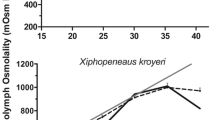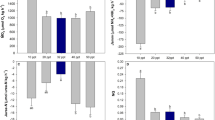Abstract
Changes in the exeretory patterns of the fresh-water field crab Paratelphusa hydrodromous were studied in relation to salinity adaptation. Fifty percent sea-water medium was found to be the threshold of a change from ammonotelism to ureotelism in the crabs. Adaptation for 11 days in the 100% (=34‰ S) sea water brought about this change. Sea-water-adapted crabs excreted more urea, uric acid, and trimethylamine than controls, irrespective of starvation. Starvation reduced the quantitative excretion. Blood aspartic and glutamic acid levels increased on adaptation to sea water, in contrast to the levels of asparagine and glutamine. The activities of asparaginase and glutaminase in the tissues decreased on salinity adaptation. The reduction in amidase activity in 100% sea-water-adapted crabs is discussed with reference to acid-base homeostasis in the crabs.
Similar content being viewed by others
Literature Cited
Baldwin, E.: An introduction to comparative biochemistry, 4th ed. 179 pp. New York: Cambridge University Press 1964.
Balinsky, J. B., M. M. Cragg and E. Baldwin: The adaptation of amphibian waste nitrogen excretion to dehydration. Comp. Biochem. Physiol. 3, 236–244 (1961).
Benoit, G. J. and L. H. Norris: Origin of trimethylamine oxide in salmon. J. biol. Chem. 158, 439–442 (1945).
Bliss, D. E., and L. H. Mantel: Adaptations of erustaceans to land. A summary and analysis of new findings. Am. Zool. 8, 673–685 (1968).
Bricteux-Gregoire, S., Gh. Duchateau-Bosson, Ch. Jeuniaux et M. Florkin: Constituants osmotiquement actifs des muscles de crabe chinois Eriocheir sinensis, adapte a 1. eau douce on à l'eau de mer. Archs int. Physiol. Biochim. 70, 273–286 (1962).
Brodsky, W. A., N. J. Carlisky, C. F. Gonzalez and Y. E. Shamoo: Metabolic pathways for urea production by the amphibian kidney. Am. J. Physiol. 208, 546–554 (1965).
Fine, A., J. Scott and E. Bourke: Studies on the glutamine aminotransferase — ω-amidase pathway in the human kidney in vitro. J. Lab. clin. Med. 80, 591–597 (1972).
Flemister, S. C.: Histophysiology of gill and kidney of the crab, Ocypode albicans. Biol. Bull. mar. biol. Lab., Woods Hole 116, 37–48 (1959).
Florkin, M., Gh. Duchateau-Bosson, Ch. Jeuniaux et E. Schoffeniels: Sur le mechanisme de la regulation de la concentration intracellulaire en acides amines libres, chez Eriocheir sinensis, au cours de l'adaptation osmotique. Archs int. Physiol. Biochim. 72, 892–906 (1964).
— and E. Schoffeniels: Euryhalinity and the concept of physiological radiation. In: Studies in comparative biochemistry, pp 6–40. Ed. by K. A. Munday. Oxford: Pergamon Press 1965.
Folin, O. and A. Svedberg: Micro-methods for the determination of non-protein nitrogen, urea, uric acid and sugar in unlaked blood. J. biol. Chem. 88, 85–96 (1930).
Goldstein, L. and R. P. Forster: The role of uricolysis in the production of urea by fishes and other aquatic vertebrates. Comp. Biochem. Physiol. 14, 567–576 (1965).
Gordon, M. S. and V. A. Tucker: Further observations on the physiology of salinity adaptation in the crab-eating frog (Rana cancrivora). J. exp. Biol. 49, 185–193 (1968).
Hartenstein, R.: Nitrogen metabolism in the terrestrial isopod, Oniscus asellus. Am. Zool. 8, 507–519 (1968).
Janssens, P. A.: Urea production and transaminase activity in Xenopus laevis Daudin. Comp. Biochem. Physiol. 13, 217–224 (1964).
Krebs, H. A.: Metabolims of amino-acids. IV. The synthesis of glutamine from glutamic acid and ammonia and the enzymic hydrolysis of glutamine on animal tissues. Biochem. J. 29, 1951–1969 (1935).
Krishnamoorthy, R. V. and V. Virabhadrachari: Carbonic anhydrase activity in the gills of Etroplus maculatus (Teleostei) as a function of salinity acclimation. Proc. Indian Acad. Sci. (Sect. B) 69, 235–240 (1969).
Krogh, A.: Osmotic regulation in aquatic animals, 242 pp. London: Cambridge University Press 1939.
Layne, E.: Spectrophotometric and turbidometric method for measuring protein. In: Methods in enzymology, Vol. III. pp 447–454. Ed. by S. P. Colowick and N. O. Kaplan. New York: Academic Press 1957.
Lyman, J. and R. H. Fleming: Composition of sea water. J. mar. Res. 3, 134–146 (1940).
Maetz, J. and G. Romeu: The mechanism of sodium and chloride uptake by the gills of a freshwater fish Carassius auratus. II. Evidence for NH4+/Na+ and HCO3−/Cl− exchanges. J. gen. Physiol. 47, 1209–1227 (1964).
Mahler, H. R. and E. H. Cordes: Biological chemistry, 872 pp. New York: Harper & Row 1966.
Maren, T. H.: Carbonic anhydrase: chemistry, physiology and inhibition. Physiol. Rev. 47, 595–781 (1967).
Meister, A.: Glutaminase, asparaginase and α-keto acid-ω-amidase (omega-amidases). In: Methods in enzymology, Vol. II. pp 380–385. Ed. by S. P. Colowick and N. O. Kaplan. New York: Academic Press 1955.
Needham, J.: Contributions of chemical physiology to the problem of reversibility in evolution. Biol. Rev. 13, 225–251 (1938).
Norris, E. R. and G. J. Benoit: Trimethylamine oxide in marine animals. J. biol. Chem. 158, 433–438 (1945).
Oser, B. L. (Ed.): Hawk's physiological chemistry, 14th ed. 1472 pp. New York: McGraw-Hill Book Co. 1965.
Owen, E. E. and R. R. Robinson: Amino acid extraction and ammonia metabolism by the human kidney during the prolonged administration of ammonium chloride. J. clin. Invest. 42, 263–276 (1963).
Pitts, P. I.: The renal production and excretion of ammonia. Am. J. Med. 36, 720–742 (1964).
Prosser, C. L. and F. A. Brown, Jr.: Comparative animal physiology, 2nd ed. 688 pp. Philadelphia: W. B. Saunders 1961.
Reddy, V. V. and P. R. A. Babu: Oxygen consumption in response to chloride uptake in the freshwater field crab Paratelphusa hydrodromous. Life Sciences (I. Physiol. Pharmacol.) 8, 739–743 (1969).
Riegel, J. A.: Excretion-Arthropoda. In: Chemical zoology, Vol. VI. pp 249–278. Ed. by M. Florkin and B. T. Scheer. New York: Academic Press 1971.
Romeu, G. and J. Maetz: The mechanism of sodium chloride uptake by the gills of a freshwater fish, Carassius auratus. I. Evidence for an independent uptake of sodium and chloride ions. J. gen. Physiol. 47, 1195–1207 (1964).
Schmidt-Nielson, K. and P. Lee: Kidney function on the crab-eating frog (Rana cancrivora). J. exp. Biol. 39, 167–177 (1962).
Schoffeniels, E. and R. Gilles: Nitrogenous constituents and nitrogen metabolism in arthropods. In: Chemical zoology, Vol. V. pp 199–277. Ed. by M. Florkin and B. T. Scheer. New York: Academic Press 1970a.
—: Osmoregulation in aquatic arthropods. In: Chemical zoology, Vol. V. pp 255–286. Ed. by M. Florkin and B. T. Scheer. New York: Academic Press 1970b.
Shalhoub, R., W. Webber and S. Glabman: Extraction of a-acids from and their addition to renal blood plasma. Am. J. Physiol. 204, 181–186 (1963).
Sharma, M. L.: Studies on the changes in the pattern of nitrogenous excretion of Orconectis rusticus under osmotic stress. Comp. Biochem. Physiol. 19, 681–690 (1966).
—: Studies on the sources and mechanism of increased urea production by Orconectis rusticus under osmotic stress. Comp. Biochem. Physiol. 24, 55–60 (1968).
—: Trigger mechanism of increased urea production by the cray fish Orconectis rusticus under osmotic stress. Comp. Biochem. Physiol. 30, 309–321 (1969).
Shewan, J. M., D. M. Gibson and C. K. F. A. P. Murray: Technical conference on fish inspection and quality control. Halifax, Nova Scotia, Canada: Fisheries Research Board of Canada (Paper F.E.FIC/69/R/16) 1969.
Smith, H. W.: Metabolism of lungfish, Protopterus aethiopicus. J. biol. Chem. 88, 97–130 (1930).
—: Froth fish to philosopher, 265 pp. Boston: Little 1953.
Wieser, W. and G. Schweizer: A re-examination of the excretion of nitrogen by terrestrial isopods. J. exp. Biol. 52, 267–277 (1970).
Wrong, O. and H. E. F. Davies: The excretion of acid in renal disease. Q. Jl Med. 28, 259–313 (1959).
Author information
Authors and Affiliations
Additional information
Communicated by N. K. Panikkar, Panaji
Dedicated to the memory of the late Professor K. Pampapathi Rao, who died on 23 June, 1973.
Rights and permissions
About this article
Cite this article
Krishnamoorthy, R.V., Srihari, K. Changes in the excretory patterns of the fresh-water field crab Paratelphusa hydrodromous upon adaptation to higher salinities. Mar. Biol. 21, 341–348 (1973). https://doi.org/10.1007/BF00381091
Accepted:
Issue Date:
DOI: https://doi.org/10.1007/BF00381091




